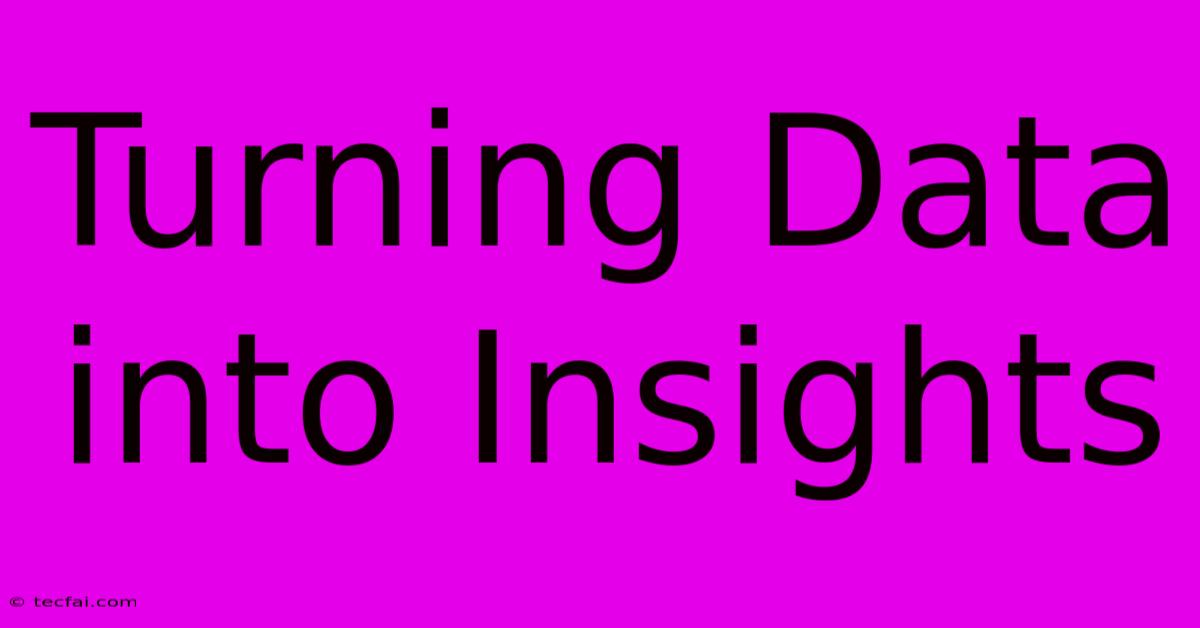Turning Data Into Insights

Discover more detailed and exciting information on our website. Click the link below to start your adventure: Visit Best Website tecfai.com. Don't miss out!
Table of Contents
- Turning Data into Insights: Unlocking the Power of Your Information
- From Data to Insights: A Strategic Journey
- 1. Data Collection & Preparation: Laying the Foundation
- 2. Data Analysis: Unveiling the Patterns
- 3. Interpretation & Visualization: Communicating Your Findings
- 4. Action & Iteration: The Continuous Improvement Cycle
- The Tools of the Trade
- Conclusion: Unlocking the Potential
Turning Data into Insights: Unlocking the Power of Your Information
In today's data-driven world, businesses are awash in information. But data, in its raw form, is just noise. The real value lies in turning data into insights. This process transforms raw numbers and figures into actionable intelligence that can fuel growth, improve efficiency, and drive informed decision-making. This article will explore the crucial steps involved in this transformation.
From Data to Insights: A Strategic Journey
The path from raw data to meaningful insights isn't always straightforward. It requires a structured approach, leveraging the right tools and techniques. Let's break down the key phases:
1. Data Collection & Preparation: Laying the Foundation
The first, and often most challenging, step is data collection. This involves identifying relevant data sources – internal databases, CRM systems, social media platforms, market research reports, and more. The quality of your insights is directly dependent on the quality of your data.
Once collected, the data needs thorough preparation. This crucial phase includes:
- Cleaning: Identifying and handling missing values, outliers, and inconsistencies.
- Transformation: Converting data into a usable format, often involving standardization, normalization, and aggregation.
- Integration: Combining data from multiple sources to create a comprehensive view.
Ignoring this stage can lead to inaccurate and misleading conclusions. Investing time and resources in data preparation is a vital investment in the accuracy of your insights.
2. Data Analysis: Unveiling the Patterns
With clean and prepared data, the next step is data analysis. This involves employing various techniques to uncover patterns, trends, and relationships within the data. Popular methods include:
- Descriptive Statistics: Summarizing data using measures like mean, median, and standard deviation.
- Exploratory Data Analysis (EDA): Visually exploring data to identify potential patterns and anomalies.
- Regression Analysis: Understanding the relationship between variables.
- Clustering: Grouping similar data points together.
- Predictive Modeling: Building models to forecast future outcomes.
The choice of analytical techniques will depend on the specific questions you're trying to answer and the nature of your data. Consider employing a combination of techniques for a more comprehensive understanding.
3. Interpretation & Visualization: Communicating Your Findings
Analyzing data is only half the battle. The real power comes from interpreting the results and communicating them effectively. This involves:
- Identifying key findings: What are the most significant patterns and trends revealed by your analysis?
- Drawing conclusions: What insights can be drawn from these findings?
- Developing recommendations: What actions should be taken based on these insights?
Data visualization plays a vital role in communicating these findings. Using charts, graphs, and dashboards can make complex information more accessible and understandable to a wider audience. Choose visualizations appropriate to your audience and the nature of your data.
4. Action & Iteration: The Continuous Improvement Cycle
Turning data into insights is not a one-off process. It's an iterative cycle. Once you've identified actionable insights, you need to implement them and monitor their impact. This feedback loop allows you to refine your approach, improve data collection, and enhance your analysis techniques over time. Regularly review and update your data analysis process to ensure it remains relevant and effective.
The Tools of the Trade
Numerous tools are available to assist in turning data into insights. These range from simple spreadsheet software to sophisticated business intelligence platforms and specialized statistical software packages. The best choice depends on your specific needs, technical skills, and budget.
Conclusion: Unlocking the Potential
Turning data into insights is a powerful process that can significantly impact your business. By following a structured approach, employing appropriate analytical techniques, and effectively communicating your findings, you can unlock the full potential of your data and drive informed decision-making. Remember, the journey from data to insights is a continuous process of learning, adaptation, and refinement.

Thank you for visiting our website wich cover about Turning Data Into Insights. We hope the information provided has been useful to you. Feel free to contact us if you have any questions or need further assistance. See you next time and dont miss to bookmark.
Featured Posts
-
Celtics Sa Nba Cup Knockout Stage
Nov 30, 2024
-
Auckland Fc Victory Black Knights Extend Winning Run
Nov 30, 2024
-
Paghingi Ng Tawad Ni Assemblyman Mali Ang Pahayag Kay Anwar
Nov 30, 2024
-
Get Your Nb Power Change Refund
Nov 30, 2024
-
Disneyland Paris Notre Dame Reopening Show
Nov 30, 2024
